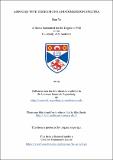Files in this item
Assouad type dimensions and dimension spectra
Item metadata
| dc.contributor.advisor | Fraser, Jonathan M. | |
| dc.contributor.author | Yu, Han | |
| dc.coverage.spatial | vii, 101 p. | en_US |
| dc.date.accessioned | 2019-07-24T15:04:04Z | |
| dc.date.available | 2019-07-24T15:04:04Z | |
| dc.date.issued | 2019-12-03 | |
| dc.identifier.uri | https://hdl.handle.net/10023/18157 | |
| dc.description.abstract | In the first part of this thesis we introduce a new dimension spectrum motivated by the Assouad dimension; a familiar notion of dimension which, for a given metric space, returns the minimal exponent α ≥ 0 such that for any pair of scales 0 < r < R, any ball of radius R may be covered by a constant times (R/r)ᵅ balls of radius r. To each 𝛩 ∈ (0,1), we associate the appropriate analogue of the Assouad dimension with the restriction that the two scales r and R used in the definition satisfy log R/log r = 𝛩. The resulting 'dimension spectrum' (as a function of 𝛩) thus gives finer geometric information regarding the scaling structure of the space and, in some precise sense, interpolates between the upper box dimension and the Assouad dimension. This latter point is particularly useful because the spectrum is generally better behaved than the Assouad dimension. We also consider the corresponding 'lower spectrum', motivated by the lower dimension, which acts as a dual to the Assouad spectrum. We conduct a detailed study of these dimension spectra; including analytic and geometric properties. We also compute the spectra explicitly for some common examples of fractals including decreasing sequences with decreasing gaps and spirals with sub-exponential and monotonic winding. We also give several applications of our results, including: dimension distortion estimates under bi-Hölder maps for Assouad dimension. We compute the spectrum explicitly for a range of well-studied fractal sets, including: the self-affine carpets of Bedford and McMullen, self-similar and self-conformal sets with overlaps, Mandelbrot percolation, and Moran constructions. We find that the spectrum behaves differently for each of these models and can take on a rich variety of forms. We also consider some applications, including the provision of new bi-Lipschitz invariants and bounds on a family of 'tail densities' defined for subsets of the integers. In the second part of this thesis, we study the Assouad dimension of sets of integers and deduce a weak solution to the Erdős-Turán conjecture. Let 𝐹 ⊂ ℕ. If $\sum_{n\in F}n^{-1}=\infty$ then 𝐹 "asymptotically" contains arbitrarily long arithmetic progressions. | en_US |
| dc.language.iso | en | en_US |
| dc.publisher | University of St Andrews | |
| dc.rights | Creative Commons Attribution-NonCommercial-NoDerivatives 4.0 International | * |
| dc.rights.uri | http://creativecommons.org/licenses/by-nc-nd/4.0/ | * |
| dc.subject | Assouad type spectra | en_US |
| dc.subject | Assouad dimension | en_US |
| dc.subject.lcc | QA611.3Y8 | |
| dc.subject.lcsh | Dimension theory (Topology) | en |
| dc.subject.lcsh | Metric spaces | en |
| dc.subject.lcsh | Fractals | en |
| dc.title | Assouad type dimensions and dimension spectra | en_US |
| dc.type | Thesis | en_US |
| dc.contributor.sponsor | University of St Andrews. School of Mathematics and Statistics | en_US |
| dc.contributor.sponsor | University of Manchester | en_US |
| dc.type.qualificationlevel | Doctoral | en_US |
| dc.type.qualificationname | PhD Doctor of Philosophy | en_US |
| dc.publisher.institution | The University of St Andrews | en_US |
| dc.identifier.doi | https://doi.org/10.17630/10023-18157 |
The following licence files are associated with this item:
This item appears in the following Collection(s)
Except where otherwise noted within the work, this item's licence for re-use is described as Creative Commons Attribution-NonCommercial-NoDerivatives 4.0 International
Items in the St Andrews Research Repository are protected by copyright, with all rights reserved, unless otherwise indicated.


